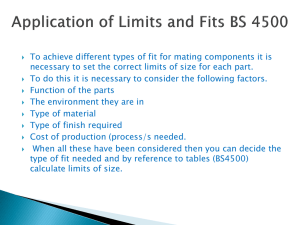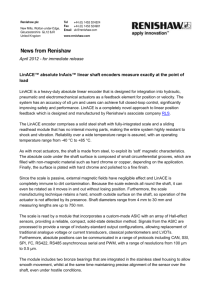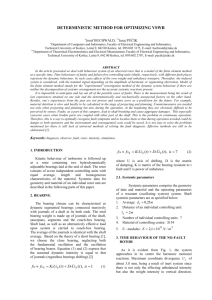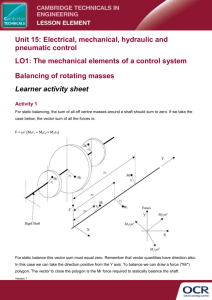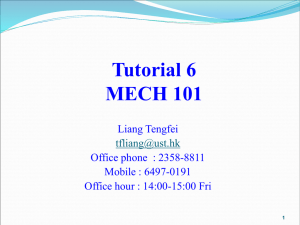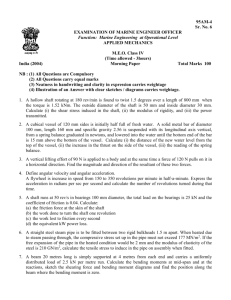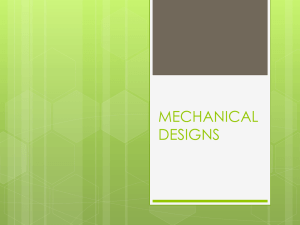Hints
advertisement
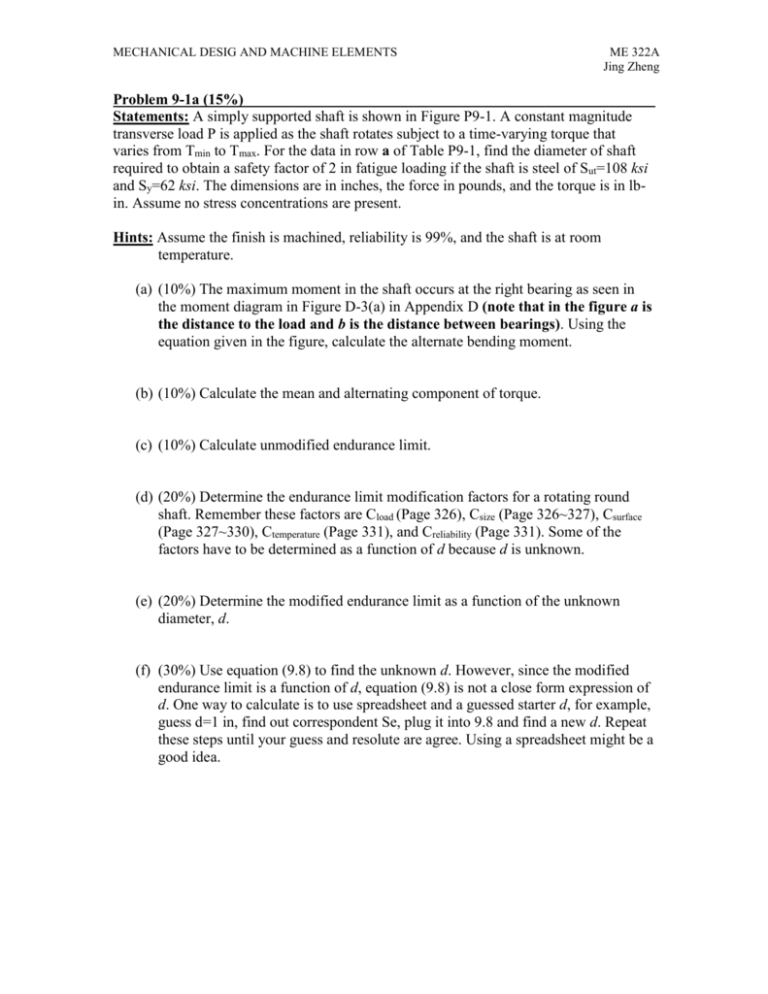
MECHANICAL DESIG AND MACHINE ELEMENTS ME 322A Jing Zheng Problem 9-1a (15%) Statements: A simply supported shaft is shown in Figure P9-1. A constant magnitude transverse load P is applied as the shaft rotates subject to a time-varying torque that varies from Tmin to Tmax. For the data in row a of Table P9-1, find the diameter of shaft required to obtain a safety factor of 2 in fatigue loading if the shaft is steel of Sut=108 ksi and Sy=62 ksi. The dimensions are in inches, the force in pounds, and the torque is in lbin. Assume no stress concentrations are present. Hints: Assume the finish is machined, reliability is 99%, and the shaft is at room temperature. (a) (10%) The maximum moment in the shaft occurs at the right bearing as seen in the moment diagram in Figure D-3(a) in Appendix D (note that in the figure a is the distance to the load and b is the distance between bearings). Using the equation given in the figure, calculate the alternate bending moment. (b) (10%) Calculate the mean and alternating component of torque. (c) (10%) Calculate unmodified endurance limit. (d) (20%) Determine the endurance limit modification factors for a rotating round shaft. Remember these factors are Cload (Page 326), Csize (Page 326~327), Csurface (Page 327~330), Ctemperature (Page 331), and Creliability (Page 331). Some of the factors have to be determined as a function of d because d is unknown. (e) (20%) Determine the modified endurance limit as a function of the unknown diameter, d. (f) (30%) Use equation (9.8) to find the unknown d. However, since the modified endurance limit is a function of d, equation (9.8) is not a close form expression of d. One way to calculate is to use spreadsheet and a guessed starter d, for example, guess d=1 in, find out correspondent Se, plug it into 9.8 and find a new d. Repeat these steps until your guess and resolute are agree. Using a spreadsheet might be a good idea. MECHANICAL DESIG AND MACHINE ELEMENTS ME 322A Jing Zheng Problem 9-4a (10%) Statements: Determine the maximum deflections in torsion and in bending of the shaft shown in Figure P9-1 for the data in row a in Table P9-1 if the steel shaft diameter is 1.75 in. Hints: (a) (25%) Calculate the area moment of inertia and the polar moment of inertia. You can find the necessary equations in Appendix A. (b) (50%) Use the equation in Figure D-3(a) in Appendix D for this overhung beam with concentrated load to determine the maximum deflection in bending. Note that in the figure a is the distance to the load and b is the distance between bearings. This deflection occurs at the right end of the shaft, under the load P. (c) (25%) Calculate the torsional deflection by using equation (9.9a). MECHANICAL DESIG AND MACHINE ELEMENTS ME 322A Jing Zheng Problem 9-8 (25%) Statements: A paper mill process rolls of paper having a density of 984 kg/m3. The paper roll is 1.50-m outside diameter (OD) x 0.22-m inside diameter (ID) x 3.23-m long and is on a simple supported, hollow, steel shaft with Sut=400 MPa. Find the shaft ID needed to obtain a dynamic safety factor of 2 for a 10-yr life is the shaft OD is 22 cm and roll turns at 50 rpm with 1.2 hp absorbed. Assumption: 1. The shaft is stiffer than the paper roll so the weight of the roll on the shaft can be modeled as a uniformly distributed load. 2. The bearings that support the shaft are close to the ends of the paper roll and are thin with respect to the length of the roll so we can consider the distance between the shaft supports to be the same as the length of the roll. 3. The shaft is machined, reliability is 99.9%, and it is at room temperature. 4. The paper machine operates 24 hours a day. 5. Do NOT be misled by Figure P9-4, it is not for this problem. 6. Figure 9-8 shown on the right is the load, shear, and moment diagrams for this problem. Hints: (a) (25%) Find the weight of the paper roll. From Figure on this page, we see that the bending moment in the shaft is a maximum at the center of the span. First, determine the magnitude of the distributed load, then find the maximum bending moment using Figure D-2(b) in Appendix D with a=0 and x=L/2. (b) (25%) Using equation 4.11b, find the maximum bending stress as a function of the unknown shaft inside diameter, id. This is the only alternating stress element present at THIS point on the shaft and there is no alternating shear stress at this point. Then, calculate the steady torque using equation (9.1a) and the von Mises stress using equation (5.7d). (c) (35%) Determine the number of stress cycles. Calculate the unmodified endurance limits. Determine the endurance limit modification factors for a rotating round shaft. Then, determine the modified endurance limit as a function of the unknown diameter, id. (d) (15%) Use equation (9.7b) to find a close form expression of id. Calculate id and Round the number down (for a thicker wall). MECHANICAL DESIG AND MACHINE ELEMENTS ME 322A Jing Zheng Problem 10-1b (15%) Statements: The shaft shown in Figure P10-1 was designed in Problem 9-1. For the data in row a from Table P10-1, design suitable bearings to support the load for at least 7E7 cycles at 1500 rpm using deep-groove ball bearings with the data given below. (b) Using deep-groove ball bearings. Hints: The shaft diameter can be reduced at the left bearing where the moment is zero. (a) (20%) The loading on this shaft is the same as that shown in Figure D-3(a) in Appendix D (not that in the figure a is the distance to the load and b is the distance between bearings). Using the equation given in the figure to calculate the left and right bearing loads. (b) (40%) Left-hand bearing: Use equation 10.19a to calculate the minimum basic load rating required for the desired L10 life. From Figure 10-23, choose the bearing with the smallest bore that has a basic load rating at least as great as that calculated in the preceding step. Choosing this bearing results in either a higher reliability (R>90%) at LD=70 million revolutions or a greater number of revolutions to failure at R=90%. Calculate the L10 life for this bearing at the design load. (c) (40%) Right-hand bearing: Use equation 10.19a to calculate the minimum basic load rating required for the desired L10 life. From Figure 10-23, choose the bearing with the smallest bore that will fit the required shaft diameter and that has a basic load rating at least as great as that calculated in the preceding step. Choosing this bearing results in either a higher reliability (R>90%) at LD=70 million revolutions or a greater number of revolutions to failure at R=90%. Calculate the L10 life for this bearing at the design load. MECHANICAL DESIG AND MACHINE ELEMENTS ME 322A Jing Zheng MIT Problem 2.70 (17%) Assumptions: The static loading diagram is shown. B1 LV Assume: l1=72 mm; l2=38 mm Assuming no axial load, ie, not a helical gear. Assuming non-corrosive environment. l1 L2 B2 Hints: (a) (10%) Calculate the bearing loading B1 and B2 with the dimension assumed as above. (40%) Calculate the two bearing’s L10 life under the load as you calculated above. (10%) What conclusion you can make about these two bearings based on your calculation? (b) (25%) Ffriction=Bi x , where Bi is the bearing loading; is the coefficient of the bearing friction, which is a constant. (c) (15%) MECHANICAL DESIG AND MACHINE ELEMENTS ME 322A Jing Zheng MIT Problem 2.70 (17%) Note: The static loading diagram is shown. RA 35 lbf RA and RB are the bearings loads at middle of each bearing. 5” 2.5” RB Hints: (a) (10%) Calculate the bearing loading RA and RB with the dimension shown above. (30%) Determine PV factor and modified PV factor by using the definition and equation on Page 18. The equation needed to determine the high load factor E is on Page 19. All other factors can be set to 1. Use Figure 6 to determine bearing life (b) (10%) Is the shaft properly retained in place? (c) (30%) Find a way to lower the bearing load. Do not be restrained by the 2.7 (b) result. (d) (20%) As shown in the figure, the shaft is smaller than the bearing bore. What will happen between the shaft and bearing bore under the loading shown? You can assume that the shaft material is stiffer than the bearing material.

